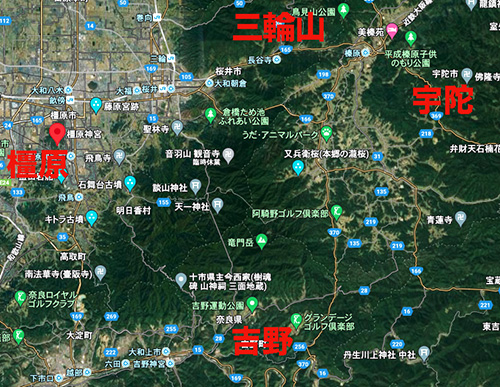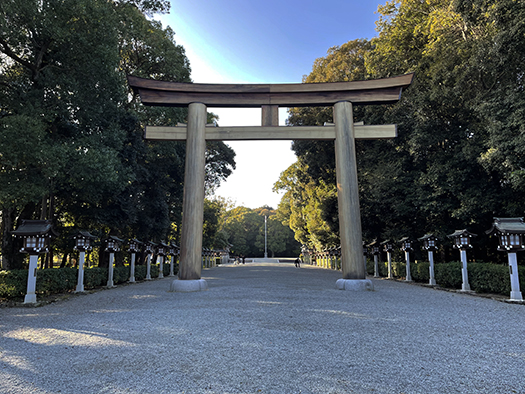

熊野を出立して八咫烏に先導されながら、神武帝の軍は大和平野の南端の吉野にいたる。そこから軍はいったん「東遷」する。大和平野全域を支配する敵対勢力・長髄彦との戦いの基本戦略として「日を背にして戦う」という方針が兄・五瀬命の遺言的戦略だったことがあったと思われる。ついでにいえば、その後の三輪山への「信仰」とも思える拝跪の底流にも、こうした側面を感じる。その後の崇神帝による「纏向(巻向)」遷都の動機にもこのことは通じていたのではないか。
話を元に戻して、神武帝の軍は山間に位置する大和平野東南端の宇陀に進出して、地元勢力を制圧することになる。「兄猾(エウカシ)・弟猾(オトウカシ)」の兄弟の勢力。<文章参照は橿原神宮発行の「由緒略記」>
ここで神話のなかでも有名なエピソードが語られる。エウカシがはかりごとを巡らして、神武帝をある御殿に入ることを勧めたという故実。しかしその建物はワナで、入ると屋根が押し潰れてなかの人が害されるというものだったとされる。ようやく「建築」ということが神話に登場してくるシーン。
この内容については後の世の「宇都宮吊り天井」逸話が連想される。日本建築と悪謀の象徴として、このふたつの話題に興味が湧く。いったいどんな「構造」であったのか、神代の時代から神話で語られるということは、一定の建築的共通認識があったと思われる。今後のひとつの探究テーマかと。
で、その悪謀は服従を選んだオトウカシの告白であきらかになり、「兄猾(エウカシ)、御殿を作ったおまえが、まず入って見ろ」と追い込んで、兄猾(エウカシ)は自業自得の最期を迎えたのだとされる。
絵伝は橿原神宮発行の「由緒略記」からのものだけれど、その後、長髄彦軍との戦いは熾烈を極めたのだとされている。その象徴的なクライマックスシーン。以下、文章転載。
〜長髄彦軍はあまりにも強くてかなり苦戦していました。すると急に黒雲が空を覆い、あたりも暗くなり、叩き付けるようにヒョウが降ってきました。そのとき暗い大空の彼方から、さあっとひと筋の光が差したかと思うと、金色のトビが神武帝の弓の先に止まり、燦然と光り輝きました。賊軍の兵達は稲光によって目を射られました。まぶしくて目を開けられず、ついに長髄彦軍は降参してしまいました。〜

こうした戦いの終結後、神武帝は畝傍山のほとりに全軍を集結させる。目の前には良質な「建築素材」である樫の森が広がっていた。そこで帝は「橿原」奠都のみことのりを高らかに宣言する。そしてこの橿原で、神武帝は初代の帝として即位する。日本の朝廷はこの「即位」を持って紀元とする。
他国では神代の権力者の多くの場合、その人物の出生をもって紀元とすることと、この点が大きく違っている。いま現代に至っても朝廷が存続し続けていることの由縁として、このことは留意される。<あすに続く>
English version⬇
The Pacification of Yamato and the Battle with Nagasuhiko: Imperial Mythology and the Kumano Journey-32
The Jinmu army left Kumano and moved east from Yoshino to fight with the “sun on their backs” strategy. Is the legend of the golden Tobi a symbol of this strategy? …
Departing from Kumano and led by Yatagarasu, Emperor Jinmu’s army reached Yoshino at the southern end of the Yamato Plain. From there, the army moved eastward. It is thought that the policy of “fighting with the sun on our backs” was the basic strategy of the war against Nagasuhiko, a hostile force controlling the entire Yamato Plain, and was the testamentary strategy of his elder brother, Gose-no-Mikoto. In addition, we can sense this aspect in the underlying principle of subsequent “faith” in the worship of Mt. This may have been the motivation for the subsequent relocation of the capital to “Mukomukai” (Makimukai) by Emperor Shinmu.
Returning to the original story, Emperor Jinmu’s army advanced into the mountainous region of Uda at the southeastern edge of the Yamato Plain to subdue the local forces. The forces of the brothers “Eu-kashi and Oto-kashi. <(The reference is to the “History of Kashihara Shrine” published by the Kashihara Jingu Shrine.
Here is one of the most famous episodes in Kashihara mythology. It is said that Eukashi played a trick on the Emperor Jinmu, persuading him to enter a certain palace. However, it is said that the building was a trap, and that if he entered, the roof would be crushed and the people inside would be harmed. This is the scene where “architecture” finally appears in the myth.
The content of this story is reminiscent of the “Utsunomiya Suspended Ceiling” anecdote from later times. As symbols of Japanese architecture and intrigue, I am interested in these two topics. The fact that the “structure” has been mentioned in myths since the time of the Gods suggests that there was a certain common architectural understanding of the structure. I think this is one of the themes to be explored in the future.
The story goes that the evil scheme was revealed in the confession of Otoukashi, who chose obedience, and that Otoukashi was driven into a corner, saying, “You who built the palace, Eukashi, go in there first, and see.
The story is based on the “Yueokibuki” published by the Kashihara Jingu Shrine, but it is said that the battle with the army of Nagasuhiko became fierce. This is the symbolic climax of the battle. The following is a reprint of the text.
〜The Chomyohiko army was so strong that they were having a hard time. Suddenly, black clouds covered the sky and it became dark. A golden kite perched on the tip of Emperor Jinmu’s bow and shone brilliantly. The soldiers of the rebel army were shot in the eyes by the lightning. Too dazzled to open their eyes, Chomyohiko’s army finally surrendered. ~~
After the conclusion of these battles, Emperor Jinmu gathered his entire army on the banks of Mount Unebi. A forest of oak trees, a high-quality “building material,” spread out before his eyes. There, the emperor announced in high spirits that he would build the capital city of Kashihara, Kashihara. In Kashihara, the Emperor Kanmu ascended the throne as the first emperor of Japan. This “accession” is considered by the Japanese Imperial Court to be the beginning of the era.
This is in sharp contrast to the fact that in most other countries, the birth of a person in power during the divine era is the time of his/her accession to the throne. This is one of the reasons why the Imperial Court continues to exist even today. <To be continued tomorrow.
Posted on 2月 7th, 2024 by 三木 奎吾
Filed under: 日本社会・文化研究







コメントを投稿
「※誹謗中傷や、悪意のある書き込み、営利目的などのコメントを防ぐために、投稿された全てのコメントは一時的に保留されますのでご了承ください。」
You must be logged in to post a comment.